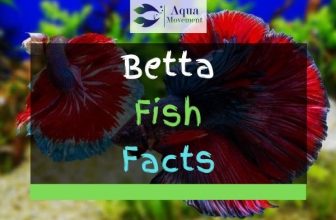7 Aquarium Algae Types With Pictures
Owning a fish tank is fun for sure but maintaining it is not as easy as you may believe.
Among the most difficult issue that every aquarist has to handle now and then is the problem of algae.
In fact, this problem makes many aquarists give up on fish keeping no matter how keen they otherwise may be.
However, there are solutions to this problem, which if you apply, you will be able to deal with it in a much better way.
So, let us get to learn about the different aquarium algae types and how you can get rid of them.
Table of Contents
What are Tank Algae?
The occurrence of algae in your tank is a natural phenomenon and it is bound to occur no matter how hard you try to keep it clean.
One thing that is in your hand is to control the degree to which it spreads and harms your tank.
Before we learn about the different aquarium algae types and how you can fight them first let us know what algae are.
They are living organisms that do not have any DNA or organized cell structure.
They can conduct photosynthesis. However, they do not have any physical features of plants like stems, roots, vascular tissue, or leaves.
Certain kinds of algae prove helpful in the survival of animals and thus are important.
Still, if they exist in too high a number they can make a tank look very unattractive and prove fatal too.
This is why if you own a tank you have to take care of the issue of algae and in a serious way.
7 Different Aquarium Algae Types
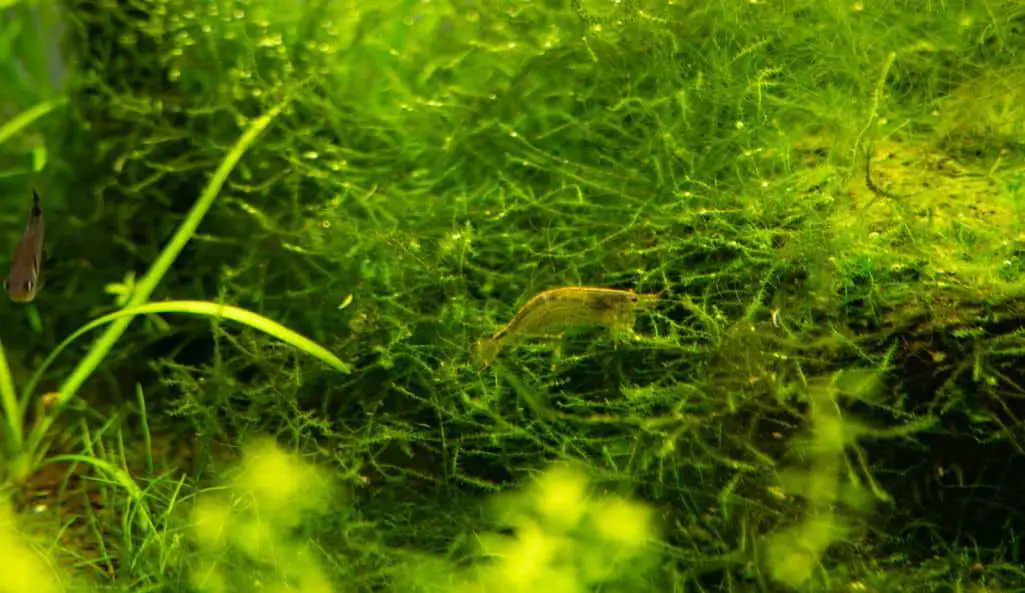
Different types of algae have to be treated in a different way.
To make things easier for you we shall help you be aware of some common aquarium algae types and the way you can control them.
Black Beard Algae
Black Beard Algae (BBA), also known as brush Algae, belongs to the Red Algae family.
Usually, you will find these algae growing in dense patches on plants and surfaces in tanks.
BBA has a blackish-green color and has a stubborn nature. Owing to this, it easily attaches itself to the plants or hard surfaces of a tank.
You cannot then get rid of it by your hand.
What does Black Beard Algae look like?
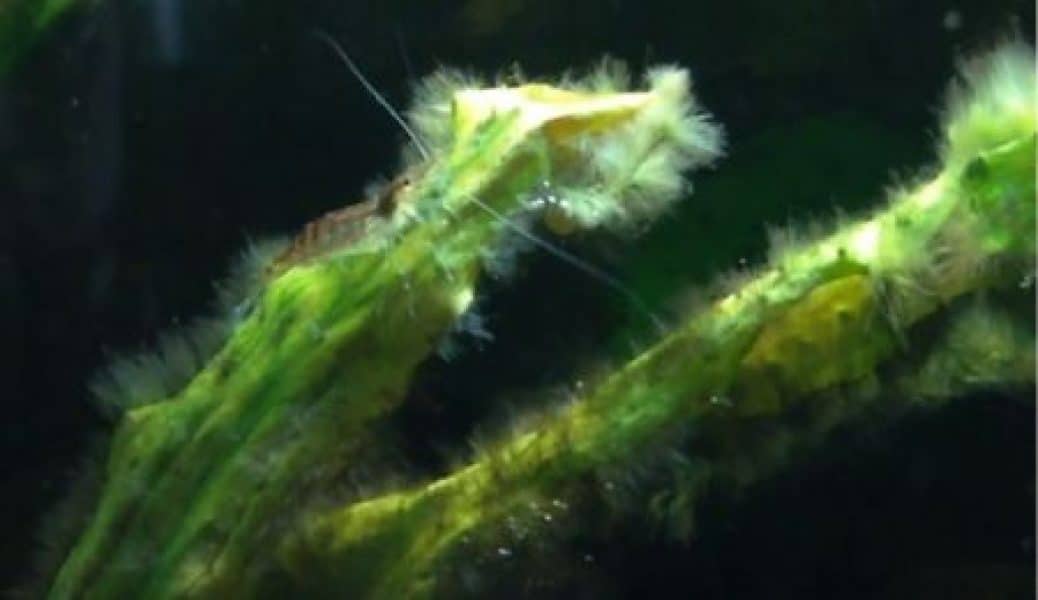
BBA first appears as black stubble. If you do not handle the problem at this stage, it will grow into a black long flowing beard.
These aquarium algae are saltwater types but you will commonly find them growing in freshwater aquariums as well.
Generally, BBA will start growing at the edges of your plant leaves and then envelop them fully.
What are the reasons behind the development of Black Beard Algae?
The main reasons behind the Black Beard Algae infestation are contaminated plants, substrate, or the decor items present in your tank.
Also, if your tank gets too much light and not enough carbon dioxide then too BBA will grow uncontrollably.
If CO2 in your aquarium is unstable then plants will not be able to use the available light and fertilizers for photosynthesis. This type of environment is favorable for the growth of BBA.
Black Beard Algae commonly reach your aquarium through contaminated plants.
Also, if some free-floating strands are present in your bag of fishes, it will be enough for it to cause great infestation.
How to cure the infestation?
Video: “How to KILL Black Beard Algae & Staghorn Algae (Easy & Quick)”
You can soak the affected plants in a ten-percent bleach solution for about 2-3 minutes to kill any algae clinging on to them.
Get rid of any heavily infested leaves. Gravel, rock, or any other items where there is a heavy infestation needs to be taken out and bleached.
Follow a proper weekly tank maintenance plan. Change the water on a weekly basis to keep the pH levels stabilized and to get back the lost minerals.
Never overfeed, and get rid of debris regularly.
You can introduce some Siamese algae eater into your aquarium. Make sure to select the right species as there are many sold under this name and will not be helpful.
If you never turn your tank’s lights off or keep them on for long hours then limiting the hours can stop BBA growth or even kill it completely.
If the CO2 levels in your tank are not proper then you need to add enough to reach the ideal levels. This may prove to be of help.
If the Black Beard Algae have attached to your aquarium then it will not be easy to get rid of it from the silicon or glass seams.
You can try using a razor, magnetic scraper, or toothbrush with a good tank spray solution for the purpose.
How to prevent BBA development?
Once Black Beard Algae infests, it is not easy to get rid of it. So, you should try preventing its occurrence in the first place.
How do you do so?
To make sure BBA does not enter your aquarium with fishes you can quarantine your new pets for a minimum of two days.
When you introduce them to your tank do not dump them through your bag directly. Instead, use a net for the purpose.
Any new plant that you buy must be prophylactically soaked in a ten-percent bleach solution for about 2-3 minutes. This will kill any algae clinging on to them.
Last but not least, purchase your fishes and plants from some reputable store.
How to Get Rid of Black Beard Algae ( Black Brush Algae) in Aquarium
Blue-Green Algae
As its name suggests, and also if you go by its appearance, you must be thinking that Blue-Green Algae (BGA) is just another algae.
It also feels like one, but the fact is it is not algae. It is a bacterium known as cyanobacteria.
Unlike all algae, the BGA has no true nucleus. But, like plants, these bacteria can photosynthesize.
There are various types of Blue-Green Algae. Some create a gelatinous lump on moist ground and are called Nostoc.
There are also some that you will find floating in the water and they are known as Microcystis.
What does Blue Green Algae look like?

Cyanobacteria appear as a blue-green, dark green, to nearly black coat on tank plants, substrate, or decorations.
They feel slimy when touched and thus is also known as slime algae. You can also identify them owing to their strange pungent smell, which can be said to be ‘earthen’ or ‘foul’.
The BGA can be filamentous to unicellular and some are also colonial. If you disturb them, they will release in sheets.
If there is an excessive growth of Blue-Green Algae it can appear as a foamy scum at the water surface.
When this alga first appears you will hardly be able to notice it, particularly if it clings on your plants.
Because of its color, it can blend with green plants of your tank easily.
You will first perhaps notice it on your rocks, substrate, driftwood, and other decorations of your tank where there is enough light.
If left untreated, the BGA will gradually cover every surface in your aquarium.
What are the reasons behind the development of Blue-Green Algae?
An overgrowth of this type of algae happens usually when there are too much dissolved wastes and nutrients in water including phosphate and nitrate.
Phosphate contributes to a great extent in the growth of BGA.
This build-up of dissolved wastes and nutrients can be because of irregular maintenance, infrequent water changes, and overfeeding.
Also, it can occur if your aquarium is new and enough helpful colonies of bacteria have not established yet.
Tap water in certain cities can be rich in phosphate and this will support the development of cyanobacteria.
It, however, can also appear in a mature, well-maintained tank.
How to cure the infestation?
Video: “How To Get Rid Of GREEN SLIME / Blue Green Algae In Aquarium – Easy Cyanobacteria Removal”
Once the infestation is huge, it is not easy to get rid of BGA.
However, one of the steps you can take is to reduce the number of nutrients in your tank water and mechanically get rid of the bacteria itself.
You can begin by vacuuming your substrate, scrubbing the plants and rocks, and scraping your tank’s glass walls.
It will be a good idea to change twenty-percent of the tank water and do not turn tank lights on for three days.
Turn the light on, on the fourth day, and again change ten to fifteen percent of water.
This should help you get control over the algae overgrowth and minimize the nutrients and wastes that help it grow.
How to prevent BGA development?
Performing water change on a regular basis and keeping your tank clean are the first steps you need to take to prevent the occurrence of BGA.
To keep the phosphate and nitrate levels under control you can perform little water change once in a week or two.
Fishes usually do not require more than one to two feedings a day. Make sure you offer only as much as your fishes will finish in 3 to 5 minutes.
Overfeeding will result in too many nutrients and thus support the development of BGA.
Too much light, especially direct sunlight, too can support the growth of Cyanobacteria.
So, try not to place your fish tank in a place where it gets direct sunlight.
4 Ways to get rid of Blue-Green Algae in Aquarium
Brown Algae
If you have a fish aquarium you perhaps may have noticed a brown film, that fills up the interiors pretty fast.
This film is called Brown Algae, Silica Alga, or Diatoms. Their infestation is normal in new aquariums which can be a cause of concern to you.
However, you will be glad to know that it is pretty easy to get rid of these algae. You can even stop it from growing if you are aware of the cause.
What does Brown Algae look like?
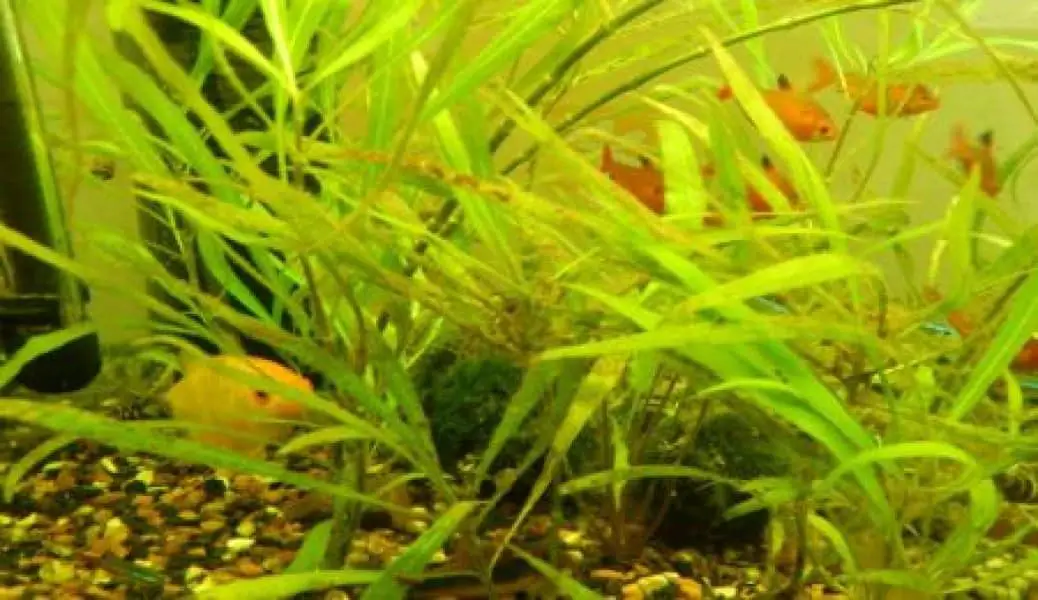
Brown Algae can be identified by its color itself. It starts appearing as brown patches on the glass or gravel of an aquarium.
Once it forms, it will not be long before it quickly covers most of the part of your tank with a dark brown, thin coating.
If you rub your fingertip over the glass the algae will feel somewhat gritty.
We have just learned about cyanobacteria. They do look a little like Brown Algae but you can differentiate between them considering how quickly they leave a surface.
In the case of Brown Algae, you will have to wipe or rub them off. When you do so just the part you touch will come off.
In the case of Cyanobacteria, you can hold a piece and peel it away in big clumps or sheets.
What are the reasons behind the development of Brown Algae?
Brown Algae are commonly found growing in newly set tanks. If you keep your tank in dark places then too these algae can develop.
When brown algae form, it even is a sign that your tank’s water chemistry does not have the right balance.
Diatoms require silica to grow. If you make use of tap water for your tank that has high silicate levels then this can help diatoms reproduce.
If silicates are not left, Diatoms can also thrive on nitrates present in tank water.
How to cure the infestation?
Video: “Why New Aquariums Go BROWN | Fixing Brown Diatom ALGAE”
Since Diatoms just rest on the bottom you can easily clean it, with no scrubbing required. You just need to wipe off all surface area inside your aquarium.
This should be followed by vacuuming the gravel.
The most difficult part here is to remove it from the gravel. However, when you vacuum it using a siphon, you will get the desired results.
If you have a freshwater aquarium, you can introduce some sucker-mouth fishes. They will eat these Brown Algae eagerly.
In saltwater aquariums, there are various types of invertebrates and fishes that are Brown Algae gazers.
How to prevent Brown Algae development?
Make sure your tank gets light at least for eight hours each day.
Keeping your tank clean will also help. Furthermore, performing partial water changes on a regular basis will prove to be a great preventative measure.
Increasing filtration can even help keep Brown Algae away. Make sure the filter you use is ideal for your tank.
Diatoms do not prefer high water flow. It likes stagnant water.
So, you can increase the flow of water and this will prevent them from attaching to the surfaces, and control their growth.
How to get rid of Brown Algae ( Diatoms ) in Aquarium
Green Algae
Among the most common aquarium algae types are the Green Algae. If it occurs in small amounts there should not be a problem.
However, if the infestation is huge, then it can make your aquarium look bad.
You definitely will then want to get rid of it as soon as is possible. You will be glad to learn that Green Algae is not a big problem and you can control it pretty easily.
What does Green Algae look like?

Green Algae have a hair-like, bushy, or slimy appearance. Though it is usually harmless you still will not want it in your tank.
This alga is quite similar to plants and forms energy with the help of photosynthesis.
The biggest issue that its presence will cause is that it might start stealing nutrients from the other plants present. Something you certainly will not want.
What are the reasons behind the development of Green Algae?
If you see that Green Algae has grown out of control and results in cloudy green water then there can be a few reasons behind this.
You may have placed your tank in direct sunlight which is a favorable condition for Green Algae to grow.
Or, you may have left the lights of your aquarium on for way too long.
If you offer excessive food in your tank then the extra left will become waste. Also, if you overstock your tank more wastes will be produced than what your water change or filter can remove.
The wastes from both these cases will result in decay. This, in turn, will release nitrates and phosphates. This is what your Green Algae need to cause an infestation.
If you do not change your water frequently and also do not clean your tank on a regular basis, that too can result in the development of Green Algae.
How to cure the infestation?
Video: “How to Fix Green Water in an Aquarium (Easiest and Cheapest Method)”
This is one of those aquarium algae types that you can even remove by your hand. Not directly using your hand though. But by using tools like scrapers and scrubbers.
After removing the Green Algae you next need to clear the decorations. To do so, first, remove them from your tank.
Next, start scrubbing them in hot water until you have removed the algae completely.
If this does not offer desired results you can use a bleach solution. This solution needs to be made by mixing ninety-five percent of water and five percent bleach.
After you have cleaned the ornament and sides of the tank make sure to vacuum the gravel.
How to prevent Green Algae development?
Though you cannot completely prevent the development of Green Algae, you certainly can control its growth.
One of the things you can do is not to keep your tank out in direct sunlight.
Also, try to use a light timer so that you do not need to remember and control the light conditions manually every day.
As plants and Green Algae require the same nutrients for survival, you can add more plants to make sure the algae does not get enough nutrients to thrive.
If you have a big tank you can add some algae eaters to prevent chances of an infestation.
How to get rid of Green Water Algae in Fish Tank
Green Spot Algae
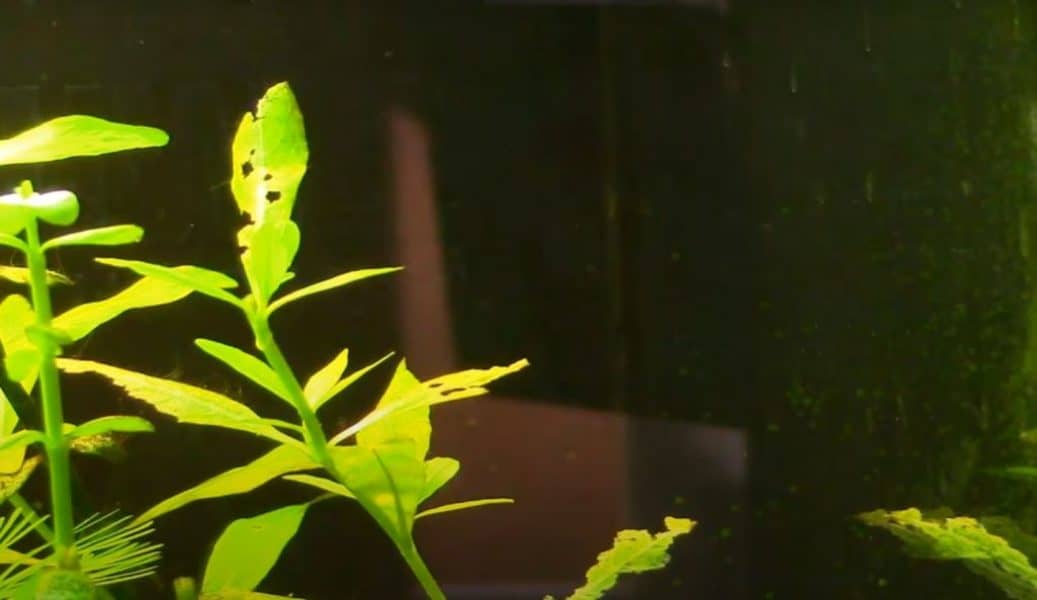
The next in this list of aquarium alga types is the Green Spot Algae. Green Spot Algae is named such because of its appearance.
It looks like round green spots, and unlike most algae, it does not grow tall. It is almost nearly flat and not easy to touch.
What does Green Spot Algae look like?
If you have seen green little spots in well-lit parts of your aquarium, they most likely are Green Spot Algae.
In the early stages, they look like isolated spots. If you are not very careful you might even miss spotting them.
Usually, people first notice them on their aquarium glass because it comes in way of their view.
The spots will appear to have a light green shade because they get hit by light from both sides. Thus, they appear lighter than they really are.
If you do not tackle the problem immediately the spots will begin merging and result in a blotchy carpet. It will not look like spots anymore and will actually appear ugly.
These algae generally grow on those objects that do not move like rocks, substrate, and also glass and driftwood.
If your tank has slow-growing plants, Green Spot Algae may grow on them as well.
What are the reasons behind the development of Green Spot Algae?
If too much light enters your aquarium, be it your tank light or direct sunlight from the window then that can result in the development of Green Spot Algae.
If your tank’s phosphate levels are too low then this too can support the growth of unsightly Green Spot Algae.
How to cure the infestation?
Video: “A “Magic” Way To Clean Your Aquarium Glass; Even Green Spot Algae”
Spot Algae can be removed mechanically. You can scrape it off your glass tank using a razor blade. As sharp objects are not good for acrylic tanks you can instead use a gentle scouring pad, a plastic razor, or a cloth pad.
Increasing the phosphate levels of your tank will also prove helpful.
You can even follow a spot treatment. If you have a solution that contains phosphate, then first turn off the filter and add the solution to the affected area.
You can also use dry KH2PO4 for the purpose. Simply combine your EI dose with tank water, just enough to dissolve it. Then, using a syringe, apply it to every affected area.
How to prevent Green Spot Algae development?
Regular water changes and cleaning are the best ways to prevent the development of this type of algae.
Make sure your tank never gets excessive light. Also, as soon as you notice the spots, treat them immediately to prevent an infestation.
Red Algae
This is one of those aquarium algae types that cannot be said to be simply harmful.
Red Algae are seen growing mostly in saltwater aquariums, though some species are present in freshwater aquariums as well.
They certainly are not one of the worst algae and can indeed prove to beneficial to your tank.
What does Red Algae look like?

Though it is usually red in color, it can also be green, blue, and black at times.
Unlike most other algae, the Red Algae or Rhodophyta (its scientific name), is multi-cellular in nature. It gets this red color from the pigment called Phycoerythrin.
Benefits of Red Algae
As already mentioned, this is one of those aquarium algae types that are also beneficial to your tank.
So, let us learn about the advantages right away.
- If you have Red Algae present in your aquarium then it significantly reduces the development of other algae. The Red Algae will also fight for nutrients and this will make it difficult for both to survive.
- Not only does Red Algae absorb the extra nutrients from the tank water, it even serves as a great type of food for your fishes.
- However, make sure to first learn about the fishes that like Red Algae before you consider introducing them to your aquarium.
- Red Algae, for its growth, consume the extra nutrients present in your aquarium. This, in turn, will keep elements like phosphate and nitrates in check. Thus your tank will always have the right balance of necessary elements.
Problems with Red Algae
If Red Algae is present under control, it is beneficial.
But, if there is an infestation, then you will have to face some problems like those that are mentioned below.
- If there is an infestation, then it can cause a problem for the other plants in your tank. As it will be absorbing as many nutrients as it can, nothing will be left for your plants. Your plants will then starve without any nutrients available for their growth.
- Red Algae are one of those that are most difficult to eliminate, and thus you must make sure there is never an outbreak.
- As the Red Algae will invade as much area as it can, they will turn your otherwise pretty looking tank into something weird.
What are the reasons behind the development of Red Algae?
Red Algae grow in low lighting conditions. So, they can easily thrive even if you forget to keep lights on for some days.
If Red Algae are common in the area you live in or in the pet store that you buy from then it can come along with your purchase.
How to cure the infestation?
Before adding plants to your aquarium, pre-treat them with bleach. Use a 1:19 bleach to water ratio.
Your plants might lose a few leaves but they will grow back once they are in the tank in the right conditions.
Adding a lot of plants can also help. Since your plants will absorb all the nutrients nothing will be left for Red Algae to feed on and spread.
Certain fishes love eating Red Algae. You can add them to your tank and thus limit their growth.
How to prevent Red Algae development?
Make sure to buy your fishes and plants only for a reputed store.
As Red Algae can grow in low light conditions, see to it that your tank gets enough light every day. Also, check the lights and see if they are working properly.
Coralline Algae
We have learned about aquarium algae types that are not beneficial, or at least not completely good for your tank.
We shall now learn about one that is beneficial and that you will want to add to your aquarium. It is none other than Coralline Algae.
What does Coralline Algae look like?
Coralline Algae is a desirable alga. Its presence indicates that you own a nicely matured marine fish aquarium,
There are two types of such algae that can exist – articulated and non-articulated.
The articulated Corallines are tree-like, branching organisms and have non-calcified sections.
The non-articulated Corallines are basically the encrusting variety. They usually grow at a slow pace on coral skeletons, live rock, plastics, glass, and other algae.
These algae are typically pink in color, but you can also see them in other shades of red, and also white, yellow, purple, and grey-green.
Why should you add them to your saltwater tank?
Coralline Algae look amazing but that is not the only reason why you would want to introduce it to your aquarium.
They offer many benefits including –
- Aquarium reefs can easily shift. If you introduce Coralline Algae they will cement rocks and reefs together. Thus, you will not have to worry about reefs dislodging when you perform your routine maintenance.
- Most Coralline Algae species release different types of chemicals that fight off other types of algae. As it grows on the surface of rocks and reefs, covering it completely, it envelops those spaces where harmful algae might otherwise grow.
How to introduce Coralline Algae to your tank?
Video: “How to Grow Coralline Algae In Your Aquarium: The Simple Truth”
Unlike most other algae, Coralline Algae will not appear in your aquarium on its own. You have to introduce it from Live Rocks or they need to be seeded.
These algae prefer a moderately-lit environment with a carbonated hardness of more than 7dkh and calcium concentration of nearly 400-440 mg/l.
Nitrates must be less than 5ppm and phosphates need to be 0ppm.
Once Coralline Algae starts growing in your tank, allow it to grow further and spread by turning off the tank skimmer and filter. But let the powerhead keep running.
Using a single-edged razor blade, remove the existing Coralline off the side and front of the tank walls.
The water current that the powerhead generates will help spread the scrapings and they will continue to grow.
Do not forget to turn the filters and skimmers on again after an hour or so.
Conclusion
Now that you are aware of different aquarium algae types and what results in their growth and how to control them, you need to be really careful.
Be observant all the time, and as soon as you notice the first signs of their appearance, take action, and eliminate them.
Just eliminating them once is not enough as they can grow yet again. So, you always have to be watchful.
Also, make sure your tank gets just enough light, not more or less, and you perform regular water changes.
Your filter system needs to be working in proper conditions as well. If you are careful all the time you can at least try to prevent an uncontrollable growth of any nuisance algae.
Remember, algae overgrowth does not only make your tank look unattractive, but it is also bad for your plants and fishes as well. So, never take any risks.
Be watchful and take timely actions. Your tank will then always look beautiful and the lives that it contains will forever be happy and healthy.





